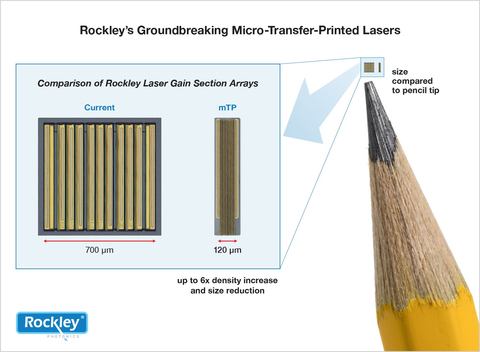- Groundbreaking achievement in micro-transfer printing increases density of Rockley’s silicon-photonics-based integrated lasers beyond previous levels
- Lays foundation for continued photonic chip size reduction and additional reductions in chip manufacturing costs
- Presents potential new commercial opportunities for Rockley, including ultra-small wearables, clothing, or XR/AR/VR headsets and glasses
- New chip technology will not impact timing of upcoming launch of Bioptx™ biosensing band or other current-generation products
Rockley Photonics Holdings Limited (NYSE: RKLY) (“Rockley”), a global leader in photonics-based health monitoring and communications solutions, today announced that it has developed what it believes to be the world’s first micro-transfer-printed (mTP) silicon-photonics-based laser for commercial applications. This groundbreaking achievement is expected to allow Rockley to further increase the density and reduce the size of its high-density spectrophotometer chips — which are already the world’s smallest for broadband infrared wavelength laser spectrometry (covering 1000 nanometers of spectrum) and are smaller in area than LED-based solutions currently used in wearables.
This press release features multimedia. View the full release here: https://www.businesswire.com/news/home/20220922005112/en/

Size comparison of Rockley’s new mTP laser array (Graphic: Business Wire)
This advancement could potentially have a significant impact across a wide range of applications, including the design of exceptionally small wearable devices for the detection and measurement of multiple biomarkers. New silicon-photonics-based biosensing chips using mTP technology are expected to be available in the first half of 2024. The new chip technology should have no impact on the upcoming launch of Rockley’s Bioptx™ biosensing band nor on any current-generation products that Rockley and its customers are developing.
With this breakthrough in the mTP of silicon-photonics-based lasers, Rockley has dramatically increased the laser density of its photonics integrated circuits (PICs) for biosensing, creating what it believes to be the world’s highest-density broad-wavelength laser spectrophotometer chip, surpassing its own previous achievements. Moreover, the mTP process is expected to reduce manufacturing costs and enable thinner, smaller footprint and higher-density chip designs. These attributes are powerful benefits for use in consumer and medtech devices and could facilitate the integration of Rockley’s biosensing technology into future tiny wearables.
Leveraging the mTP process, the new PIC technology will integrate a laser-generating “membrane” with a thickness of only 4 microns. The potential applications for this higher-density and smaller-footprint chip technology extend beyond biosensing and health monitoring into other areas, such as ultra-small wearables, clothing, or XR/VR/AR headsets and glasses.
This mTP breakthrough is the direct result of Rockley’s multi-year partnership with the Tyndall National Institute at University College Cork in Ireland, X-Celeprint Limited, and the Irish Photonics Integration Centre (IPIC), with funding support from the Irish government’s Science Foundation Ireland (SFI) and Disruptive Technologies Innovation Fund (DTIF). The project started five years ago with a focus on developing a custom mTP process for Rockley’s silicon photonics platform and has involved a multidisciplinary team of world-class engineers and researchers. This technology, along with many other Rockley innovations, is backed by a robust multidisciplinary patent portfolio of over 200 issued patents and 295 pending patents in total.
“Applying the micro-transfer printing process to the production of integrated lasers is a huge breakthrough that we believe will have a tremendous impact on wearable biosensing and on the photonics industry as a whole,” said Dr. Andrew Rickman, chairman and chief executive officer of Rockley. “We arguably have some of the most sophisticated photonics technology in the world, and this unprecedented level of miniaturization raises the bar even further. By creating biosensing chips that are smaller, lower-cost, and more efficient, we can continually improve our wearable biosensing products and deliver novel, relevant, and more powerful ways to monitor our health.”
“I believe that this next-gen, heterogeneous integration platform will lead to several significant technological advancements, including higher densities of lasers, increasingly smaller chip sizes, and ultra-high-volume manufacturing,” said Aaron Zilkie, chief technology officer of photonics at Rockley. “The team has been working on this project for years, and we are extremely excited to have reached this important milestone. We are grateful for the close collaboration we’ve had with our research partners and for the funding support from the Irish government and its Science Foundation Ireland and Disruptive Technologies Innovation Fund.”
About Rockley Photonics
A global leader in photonics-based health monitoring and communications solutions, Rockley Photonics is developing a comprehensive range of photonic integrated circuits and associated modules, sensors, and full-stack solutions. From next-generation sensing platforms specifically designed for mobile health monitoring and machine vision to high-speed, high-volume solutions for data communications, Rockley is laying the foundation for a new generation of applications across multiple industries. Rockley believes that photonics will eventually become as pervasive as micro-electronics, and it has developed a platform with the power and flexibility needed to address both mass markets and a wide variety of vertical applications.
Formed in 2013, Rockley is uniquely positioned to support hyper-scale manufacturing and address a multitude of high-volume markets. Rockley has partnered with numerous tier-1 customers across a diverse range of industries to deliver the complex optical systems required to bring transformational products to market.
To learn more about Rockley, visit rockleyphotonics.com.
Cautionary Note Regarding Forward-Looking Statements
Statements in this press release that are not historical facts constitute “forward-looking statements” for purposes of the safe harbor provisions of the Private Securities Litigation Reform Act of 1995. These forward-looking statements include statements regarding Rockley’s future expectations, beliefs, plans, objectives, and assumptions regarding future events or performance. The words “accelerate,” “advance,” “anticipate,” “believe,” “can,” “capability,” “continue,” “could,” “develop,” “enable,” “enhance”, “estimate,” “eventual,” “expand, “expect,” “focus,” “forward,” “future,” “goal,” “ground-breaking” “intend,” “may,” “might,” “opportunity,” “outlook,” “plan,” “possible,” “position,” “potential,” “predict,” “project,” “revolutionize,” “seem,” “should,” “trend,” “vision,” “will,” “would” or other terms that predict or indicate future events, trends, or expectations, and similar expressions or the negative of such expressions may identify forward-looking statements, but the absence of these words or terms does not mean that a statement is not forward-looking. Forward-looking statements in this press release include, but are not limited to, statements regarding the following: (a) the potential of Rockley’s sensing platform to provide a complete end-to-end solution that enables the non-invasive, continuous, and near-real-time monitoring of multiple biomarkers; (b) our belief that we have developed the world’s first commercial micro-transfer-printed laser and the world’s highest density spectrometry chips for wearable health monitoring, and our belief that these developments will produce significant additional reductions in chip manufacturing costs, improve power efficiency, potentially enhance performance of our products, and present new commercial opportunities and applications; (c) the timing of the availability of our products and technology; (d) our belief that we are laying the foundation for a new generation of applications across multiple industries, and the extent to which we may expand our focus beyond biosensing solutions; (e) our belief that photonics will eventually become as pervasive as micro-electronics; and (f) our potential to support hyper-scale manufacturing, address a multitude of high-volume markets, and deliver the complex optical systems required to bring transformational products to market.
Forward-looking statements are subject to several risks, assumptions, and uncertainties (many of which are beyond Rockley’s control) that may cause actual results or performance to differ materially from those expressed or implied by these forward-looking statements. These risks, assumptions, and uncertainties include, but are not limited to, the factors described under the heading “Risk Factors” in our Annual Report on Form 10-K for the year ended December 31, 2021, and in other documents we file with the Securities and Exchange Commission. If any of these risks or uncertainties materialize, or should any of these assumptions prove incorrect, actual results may differ materially from those discussed in or implied by these forward-looking statements. There can be no assurance that future developments affecting Rockley will be those that have been anticipated. Given these risks and uncertainties, you should not place undue reliance on these forward-looking statements. These forward-looking statements speak only as of the date hereof and Rockley does not intend to update or revise any forward-looking statements, whether because of new information, future events, or otherwise, except as required by law.
View source version on businesswire.com: https://www.businesswire.com/news/home/20220922005112/en/
Contacts
Media
Debra Raine
Rainemakers
Telephone: +1 415-349-7432
Email: rockleyphotonics@rainemakers.com
Investors
Gwyn Lauber
Rockley Photonics
Telephone: +1 626-995-0001
Email: investors@rockleyphotonics.com





